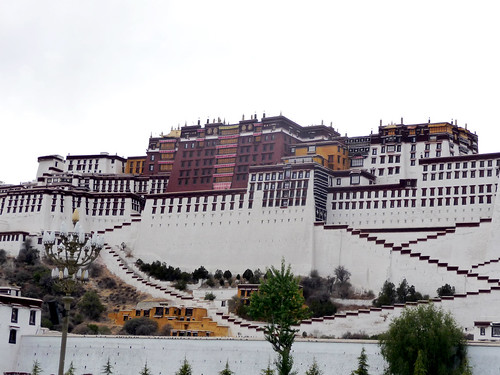
After Gyanze, the next day we drove for about 5 hours into Lhasa itself. I had heard reports that Lhasa was disappointing and that much of the culture was gone, but I found it a rich and fascinating place. It was easy to get off the main drag a bit, duck into a Tibetan tea house, and have a real encounter with Tibetans. I made a couple Tibetan friends this way, which really opened up the city for me.
The official tour lasted for two more days in Lhasa, and was packed seeing the major sights of the city. The first day we went to the iconic Potala Palace, which looms above the city and is the universal symbol of Lhasa. It used to be the residence of the Dalai Lama, but obviously that's not an option anymore, so it has been turned into a sort of museum. Though definitely not a living religious place, the riches and history contained inside are pretty amazing. There is just room after room of Buddha statues, huge and ornate tombs of previous Dalai Lamas, libraries of ancient Buddhist scriptures, and the preserved living quarters of the Dalai Lama.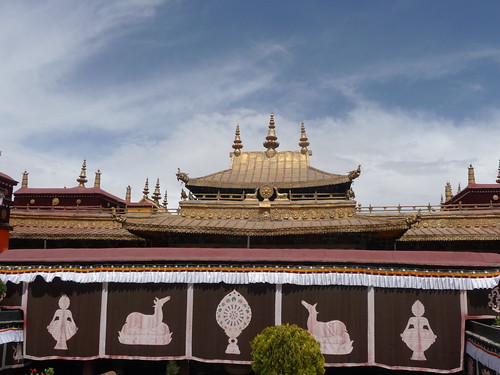
Next up was the Jokhang Temple. This is the spiritual heart of the city. Although the interior had been mostly destroyed by the Cultural Revolution and was rebuilt basically new, it is still immensely important to the Tibetan people.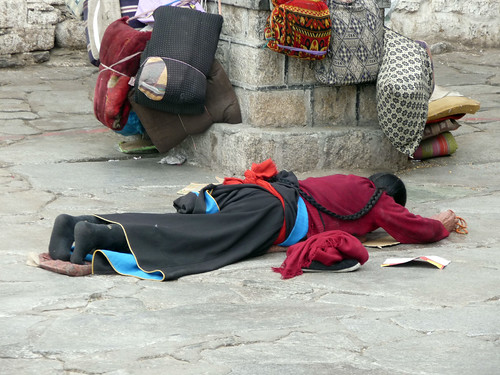

There was always a group of people performing prostrations on the pavement in front of the temple, and the central kora around the temple was constantly full of devout Tibetans swinging their prayer wheels. The people watching was just out of this world - Tibetans from all of the different regions, each with their unique traditional clothes: Kham, Ando, and others. I found myself returning again and again to this area to soak up the atmosphere (and eat some great mo-mos).
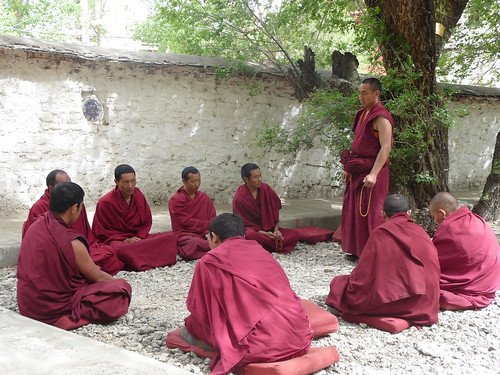
The final day of the tour we went to the two major monasteries near Lhasa: Drepung and Sera. These were largely rebuilt after the Cultural Revolution as well, so it was less interesting to me to see the temples themselves. We were able to see the debating monks at Sera, who were much more animated and exciting to watch than those at the earlier monastery in Shigatse.
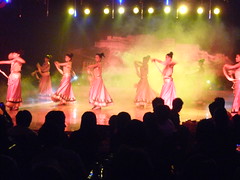
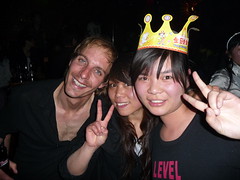
The last night of the tour, a bunch of us went clubbing to celebrate our friend Art's birthday. Going out in Lhasa was like nothing I've ever seen - though I think it was more of a Chinese experience than a Tibetan one. The first place we went had a huge stage where professional performers would come out and sing karaoke songs to us (my group went wild when this Chinese guy sang the 4 Non-Blondes song, "What's Going On", and "La Isla Bonita"). The karaoke was interspersed with large dance numbers featuring a ton of people in ethnic costumes, and also Chinese line-dancing where the audience came up on stage. We all went up to dance to one number and the police evidently came in and surrounded the stage - don't know what that was about.
The next place was more of a proper dance club, complete with stripper poles, rapping Chinese girls, and a ladyboy dancer behind the dj. I found myself dancing with a good-looking, extremely tall Chinese guy (as tall as me, how refreshing!) though he was too hyper of a dancer and I had to step off. At the end of the night there was a tent set up outside the club where you could have anything you imagined fried up: pork, chicken, liver, yak (of course), cauliflower, corn, etc. A little (deep-fried) slice of heaven.
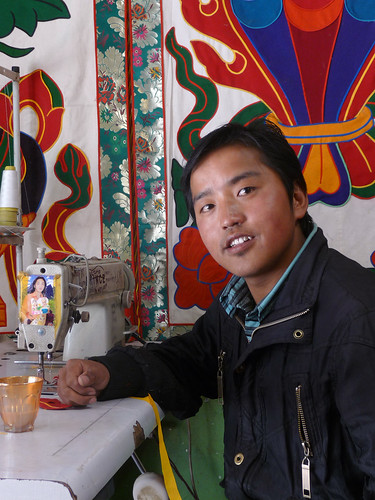
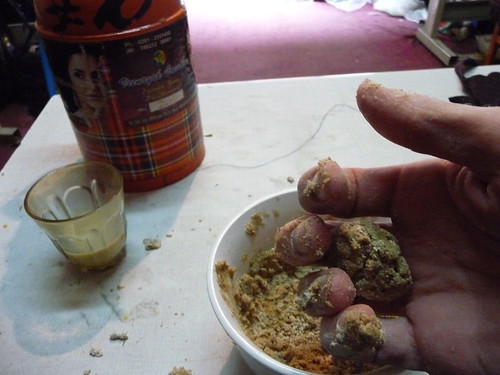
After the tour ended and I slept off my hangover, I spent the next few days on my own exploring the city. I made friends with a super-nice guy, Pon Tsok, who made Tibetan tapestries. I would go and visit him every morning in his shop and he would practice his English on me while feeding me tsampa and pouring me an ungodly amount of tea. To eat tasmpa, you start with barley flour and add a little yak butter tea to it. Then you work it with your fingers into a ball of dough and put it in your mouth. Not bad, though messy for the clumbsy Western fingers. Pon Tsok invited me to his English class one night, which was fun. I had other students passing me notes asking me to define what penquins and dolphins were (not sure if my drawing of a penguin helped - I think they thought it was a duck). After class a bunch of them took me out to dinner to practice more English.
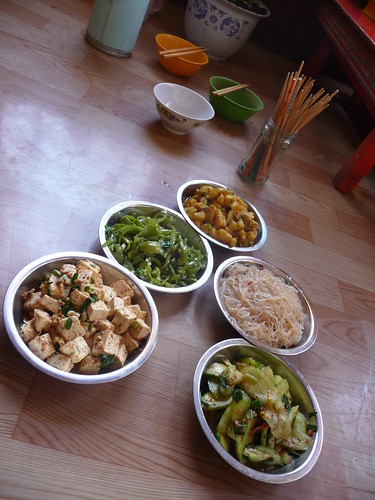
One my final day before I took off, I took a taxi out to the Ganden Monastery, about an hour outside of town. My taxi driver stopped off at a store to buy some juice and fruit, which seemed like a bit of a strange time to do some grocery shopping. Turns out that he's friends with the head lama at the monastery, and brought the food up to him as an offering. He led me into the lama's private apartment and I was able to have an audience with him for over 2 hours! This was the most amazing experience of the trip. The lama didn't speak much English, but we were able to communicate fairly well with gestures and a few words. He was very curious about life in America, and had such a joyful presence that I enjoyed simply being around him. His assistant cooked a delcious meal of stirfried vegetables and tofu, which I shared with the lama, the assistant and my taxi driver.
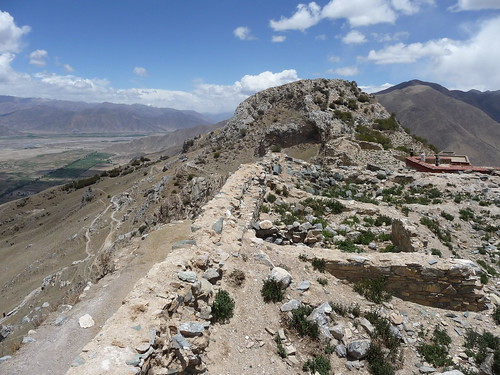
Afterwards, I walked around the monastery, which though much has been rebuilt, still shows the ruins of buildings that had been destroyed by the Chinese. Very sobering to see this reminder of what happened across the country to nearly all of the monasteries.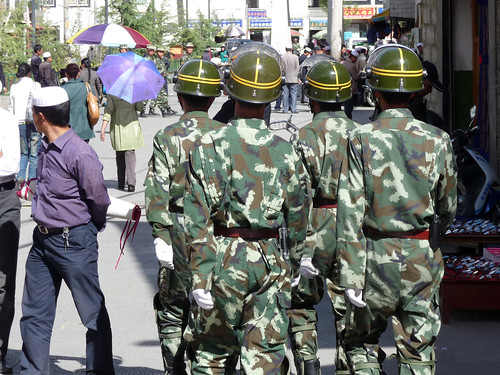
I was reminded throughout my trip, but especially in Lhasa, that this was a country under occupation. Many small groups of Chinese soldiers marched around the city center making their presence known - you would run into them every few minutes. I talked to a number of monks and other folks during the tour, and was frequently made aware of the threat of speaking out against the Chinese government, even among friends. One monk at a monastery knew no English but was quite good at pantomime. He mimed a monk talking too much, and then being led off in handcuffs. Other folks I talked to in a restaurant pointed at the ceiling and made the "shhhh" sign - there were microphones everywhere. I was told that the police had a habit of suddenly showing up and carting someone off if they talked about the Dalai Lama or the current political situation.
Another monk pointed at numerous places around a monastery, make a flattening motion with his hand indicating buildings being destroyed, and say one word: "Mao". Someone else told me of the visa system for monks: I was wondering why so few monks were living at the recently renovated monasteries, and it turns out it is because you need to be granted a "monastery visa" by the Chinese government. So the number of monks is strictly controlled, as is their make-up. We heard stories of informant monks who were planted by the Chinese inside of the monasteries.
All the while that the Tibetans communicated these stories of terrible destruction and repression to us, their eyes gleamed with good humor and happiness. Such was the contrast I saw over and over, where Tibetans would bear witness to the awful things that had happened to their country, but endure their hardship with pride and grace.
On the flight back to Kathmandu I randomly ran into two Austrian guys who had rescued me when I fell ill on the trail of the Helambu Trek in Nepal. A cool coincidence and good to catch up. We flew over the Himalayas and had a close, clear view of Mt. Everest as a conclusion to the trip.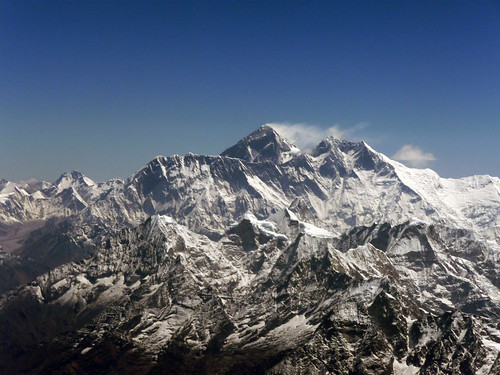
Sunday, June 14, 2009
Lhasa
Subscribe to:
Post Comments (Atom)
0 comments:
Post a Comment